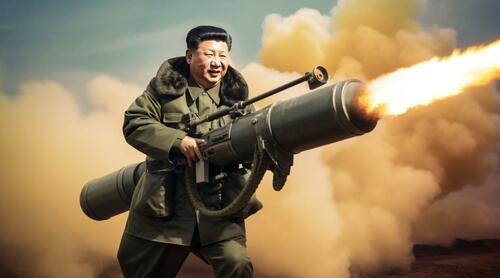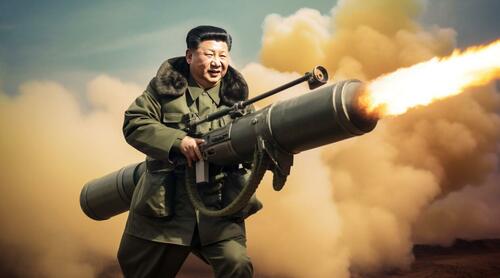Will China’s „Whatever It Takes” Moment” Work
By Marcel Kasumovioch, Deputy CIO of Coinbase Asset Management
“We need to establish a strong benchmark for selecting and employing people, conscientiously implement the ‘three exemptions,’ and support those who take responsibility and get things done.” This statement from the extraordinary Politburo meeting left no doubt about the leadership’s intentions.
Those who demonstrate “the courage to take responsibility and innovate,” in Xi’s words, will be rewarded, with exemptions, a “responsibility and punishment” waiver for those acting on policy guidance. The thousands of financial executives who exited their positions and the Party since August serve as a reminder to those who resist.
The Politburo followed sweeping actions taken by the central bank, in solidarity with PBOC governor joining the heads of the NAFR and the CSRC in announcing the measures. These included rate cuts, property loans for unsold homes, and equity buyback facilities – policies that underscore China’s desire for firm control over its economy, directing the capital of savers like the strings of a puppet rather than relying on the invisible hand of the market.
China’s economy is cluttered with unsold homes, unfinished projects, and unused land, totaling an astonishing $4.1 trillion at mid-year. This isn’t China’s first financial hurdle: restructuring the FX market in 1994, bank overhauls in 1998 and 2004, asset management crackdowns in 2015, and the COVID response all showcased the country’s approach to handling economic strains.
Financial repression and the central bank’s balance sheet softened these shocks before – and once again, this playbook of control is in motion. But as China’s economy grows more complex, maintaining this control becomes increasingly difficult. The global economy is infinitely more complex and managing it through sheer willpower alone is impossible.
Reform, not stimulus, requires real courage. And it’s a global issue. A good economy is one that works for the many, not the few. Markets have a way of identifying and enforcing necessary reforms for that outcome, and nations that heed this call will strengthen their standing – near-term pain for long-term gain. After all, no country can simply inflate its way to prosperity.
Courage:
“The vast majority of party members and cadres must have the courage to take responsibility and dare to innovate,” Xi conveyed with urgency at this week’s Politburo meeting. The timing of the meeting itself reflected the gravity of the situation, being held earlier than usual. The Politburo introduced a rare “responsibility and punishment” waiver, offering protection to officials willing to embrace Xi’s challenge. This marks China’s “whatever-it-takes” moment, where pragmatic policies take precedence: a good economy is one that works.

The foundation of Xi’s “courage economy” was laid the day before:
- PBOC rate cuts will inject 1 trillion RMB in liquidity, while loans for unsold homes can now cover the entire purchase price.
- The downpayment requirement for second-home buyers was reduced to 15%, in line with first-time buyers.
- Meanwhile, bank regulators committed to a more gradual increase in capital requirements, and specialized refinancing facilities were established to encourage equity buybacks.
These coordinated actions signal a unified directive to stabilize the economy.
Deng Xiaoping famously quipped, “It doesn’t matter whether a cat is black or white, as long as it catches mice,” as China began its economic reforms in 1979. Desperate for an effective economy, China sought to balance traditional goals with pragmatic policies. Unlike many emerging markets with lofty objectives, China has managed to execute with its share of world GDP rising from 2% in 1980 to nearly 20% today. How did it avoid the pitfalls of past crises? Through a strong emphasis on domestic control — a policy that does not scale well.
Mousetrap:
Take China’s navigation of the 1990s Asia crisis. While its neighbors experienced fierce capital outflows, currency devaluations, and bank failures, China maintained its FX peg at around 8.33 to the US dollar. Stability masked material internal strain, with non-performing loans for Chinese state banks surging to 24% in 1998. But it was a domestic issue—by 1997, FX reserves were eight times greater than short-term external debt. Banks were restructured, imposing losses on domestic savers through reduced returns and financial repression.
The repression strategy was repeated in 2004 and 2016 and now underpins the latest policy measures. China’s gross national saving rate is 43% of GDP, a captive audience given limited options for allocating their funds. As a result, these savers endure abysmal rates of return—the dark side of financial repression. It’s far from a free lunch. From bonds to stocks to real estate, this captive audience pays the price for policy through depressed returns. Market economies must do more with less, competing for global capital in freer environments.
Will the “courage economy” work? In the near term, almost certainly yes. But its limitations are equally clear. China’s gross national saving rate is falling, shrinking the pool of capital available to plug financial holes in an increasingly complex economy. Leaders cannot strengthen an economy by willpower alone—incentives do the heavy lifting. Financial repression merely defers problems to the next generation, a global issue with more immediate consequences for China’s shrinking population. The time for a new trap to catch the mice may soon come.
Anecdote:
„It’s not the mindset of an emerging market. It’s the mindset of an emerging superpower,” said one of the greatest macro investors of all time to me, his eager protege. This time, it was China’s FX revaluation making the headlines – not the investor’s famous predictions of devaluations in the past.
“The world mistakes China as ideological. 1979 marked the shift to pragmatism,” he continued, referencing the pivotal moment when Deng Xiaoping opened China’s doors to the world. “It doesn’t matter whether a cat is black or white, as long as it catches mice,” the protege eagerly recalled from Deng, encapsulating the shift to a results-driven economic policy.
China’s appearance at the 1979 World Economic Forum marked the beginning of its new economic era. Controlling inflation became a priority, achieved after 15 years of effort. The two-tiered foreign exchange system was replaced in 1994, laying the groundwork for a modern, integrated economy – though not without one last devaluation to prepare for the transition.
China managed banking crises internally, with bank recapitalizations in 1998 and again in 2004. These were not the actions of a typical emerging market. “Deng’s approach seems almost ruthless in its pragmatism,” I ventured. And only a decade after the last devaluation, the US Senate demanded an upward revaluation of the currency or else China would face a hefty 27.5% import tariff.
Learning from Japan’s painful experience after Plaza Accord, China adjusted on its own terms. “China is rewriting the rules,” the investor remarked, his eyes narrowing as if seeing the threads of history weaving into the present. “Markets must read them carefully…and politicians will need a heavy pen when editing.”
The revaluation proved a very profitable day. There were no celebrations, no false glory – just a relentless focus on what comes next, recognizing the shift in the global power dynamic. For China, it wasn’t about winning a battle. It was about redefining the entire game. And I realized the true lesson. This was not just about currency or trade, but about a nation’s unwavering commitment to its vision of the future, one strategic step at a time.
Tyler Durden
Sun, 09/29/2024 – 18:40
